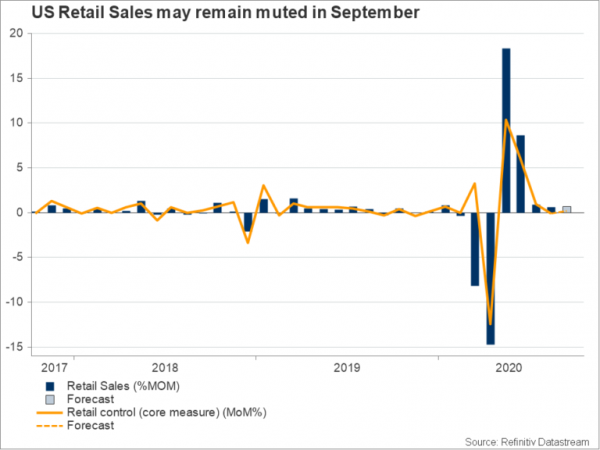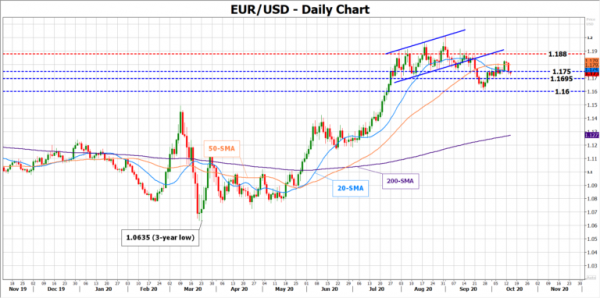The US calendar will get busier at the end of this week amid a turbulent presidential campaign and a fiscal stimulus drama. But among all data, the focus will be on retail sales for September released Friday at 12:30 GMT. Particularly, markets would like to find out how household spending in the world’s biggest economy is progressing during the present coronavirus conditions, but the results may not paint a rosy picture.
The reduced $300 weekly unemployment benefit which Trump extended for six weeks expired in mid-September in several states and Congress was unable to provide another round as Senate Democrats insisted on a larger package that Republicans opposed. The unemployment rate has been declining after striking a multi-year high in April, but it is still way above pre-Covid levels and thousands of people continue to apply for jobless claims every week, making any delay crucial for the health of the economy given that consumption accounts for two-thirds of it.
Markets got even more concerned and confused when Trump called off stimulus talks until after the election on November 3 before suddenly saying he is offering a bigger package of $1.8 trillion the past Friday, which is closer to Democrats’ $2.2 trillion proposal. Nevertheless, surprisingly investors did not get extremely nervous given Wall Street’s positive reaction. Instead, they saw the glass half full and not empty, likely considering that in case there is no agreement ahead of the election and Trump gets defeated, Democrats’ Biden may deliver a more generous package next year.
However, the latter could be a struggle if Democrats cannot gain a majority in the Senate, where Republicans have control, resulting in prolonged fiscal talks. The economy could get a stronger hit if the virus conditions worsen during the winter months, new lockdown measures take effect, and millions of unemployed remain without help.
Retail sales may not bring exciting news
Although no governing party would leave its economy helpless in the above extreme scenario, it could take some time to push for its demands if the data do not show a significant slowdown and hospitals have sufficient capacity. On Friday, retail sales, are expected to tick up to 0.7% m/m from 0.6% in August though excluding automobiles, the measure is forecast to ease by 0.2 percentage points to 0.5%, suggesting that household spending is still weak. The retail control gauge which also excludes energy products could come in lower at 0.2% but above August’s print of -0.1%.
Market reaction
As regards the market reaction, the dollar will probably be most affected by political and stimulus headlines over the next few weeks and its safe-haven features could make it difficult for any news to bring big harm. Nevertheless, some temporary weakness cannot be excluded in the wake of disappointing data with risky currencies such as the euro and the pound finding an opportunity to steal some shine.
Looking particularly at EUR/USD, lower-than-expected retail sales could help the pair to extend its recovery from the 1.1611 low and it would be interesting to see if it will manage to break above the 1.1880 barrier and back into the ascending channel. Higher, a violation of 1.1930 may send the price towards the 1.2009 high.
Otherwise, a stronger-than-expected outcome may pressure the pair below the 1.1750-1.1695 area, while lower the 1.1611 low will be the next target.














